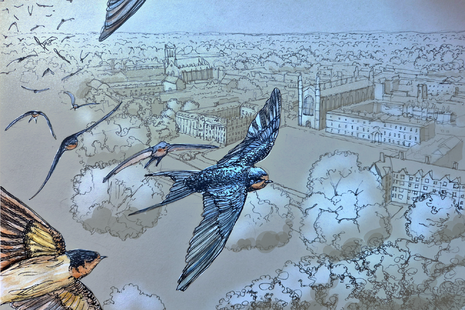Science
Understanding Bird Migration Could Shape Future Quantum Computing

As autumn approaches, the seasonal transition in Cambridge signals the departure of swallows and swifts, making way for the arrival of redwings and fieldfares. This shift is part of a broader phenomenon, as approximately 20% of the world’s bird population migrates to warmer climates during winter months. The intricate migratory patterns of birds have intrigued scholars for centuries, with even ancient philosophers like Aristotle proposing theories on their behaviour. Current understanding reveals that birds undertake remarkable annual journeys, travelling thousands of miles between regions like the UK and Africa.
Birds primarily rely on visual cues for navigation, similar to the way sailors have depended on the stars for direction. They navigate using both geographical landmarks and the celestial rotation around the North Star. Although these visual methods are critical, the specific migratory routes are often genetically encoded. Birds that inherit differing migration pathways from their parents typically adopt an intermediate route. Research indicates that the initial migration is crucial, as many birds will follow the same path for the rest of their lives.
In addition to visual navigation, birds possess a unique ability known as magnetoreception, which allows them to sense the Earth’s magnetic field for orientation. Despite being a topic of ongoing study, scientists are gaining insights into how birds detect magnetic fields. There are two leading hypotheses: one postulates that bird tissues contain crystals of magnetite that align with the magnetic field, while the other, proposed by Klaus Schulten in 1978, suggests that this ability is linked to quantum processes.
Understanding Schulten’s theory involves basic concepts of chemistry. When covalent bonds between atoms break, they can do so in two distinct ways: heterolytically or homolytically. The latter generates free radicals, which have unpaired electrons characterized by a property called ‘spin.’ In a chemical reaction, the formation of free radical pairs can result in electrons with either parallel or antiparallel spins. The constant switching between these states, influenced by external magnetic fields, potentially explains how birds navigate using magnetoreception.
Current research is focusing on a specific protein called cryptochrome 4, believed to facilitate this light-dependent magnetic sensing. These findings are proving valuable, as researchers aim to harness insights from bird migration to advance quantum computing technology.
Another intriguing area of study is how migrating birds manage to function on minimal sleep. Many songbirds appear to utilize short periods of rest, or ‘micronaps’, to sustain their physiological functions during long migrations. While humans may not be able to replicate these strategies, the U.S. Defense Advanced Research Projects Agency (DARPA) is investing in research to explore the neural circuits involved in bird migration, aspiring to develop a ‘no-sleep soldier.’
Despite the remarkable adaptations of migratory birds, human activities pose significant challenges to their survival. A 2022 study indicated that bird species richness is lower in areas with wind turbines compared to control sites, suggesting that man-made structures may disrupt migratory patterns. Additionally, artificial lighting at night can attract nocturnally migrating birds, leading them to circle around urban areas, increasing their risk of collision with buildings and depleting their energy reserves for flight.
As you observe a swallow preparing for its long journey to Africa or a redwing arriving from Scandinavia, consider the intricate mechanisms that enable these birds to navigate and thrive. The study of migratory birds not only deepens our appreciation for nature but also holds the potential to inform technological advancements in quantum computing and other fields. Understanding their remarkable adaptations will undoubtedly contribute to future innovations.
-

 World3 days ago
World3 days agoCoronation Street’s Shocking Murder Twist Reveals Family Secrets
-

 Entertainment4 months ago
Entertainment4 months agoKate Garraway Sells £2 Million Home Amid Financial Struggles
-

 Entertainment3 months ago
Entertainment3 months agoAnn Ming Reflects on ITV’s ‘I Fought the Law’ Drama
-

 Health3 months ago
Health3 months agoKatie Price Faces New Health Concerns After Cancer Symptoms Resurface
-

 Entertainment3 weeks ago
Entertainment3 weeks agoCoronation Street Fans React as Todd Faces Heartbreaking Choice
-

 World4 weeks ago
World4 weeks agoBailey Announces Heartbreaking Split from Rebecca After Reunion
-

 Entertainment6 days ago
Entertainment6 days agoTwo Stars Evicted from I’m A Celebrity Just Days Before Finale
-

 World6 days ago
World6 days agoKevin Sinfield Exceeds Fundraising Goal Ahead of Final Marathons
-

 Entertainment3 months ago
Entertainment3 months agoCoronation Street’s Carl Webster Faces Trouble with New Affairs
-

 Entertainment3 months ago
Entertainment3 months agoWhere is Tinder Swindler Simon Leviev? Latest Updates Revealed
-

 Entertainment4 months ago
Entertainment4 months agoMarkiplier Addresses AI Controversy During Livestream Response
-

 Science2 months ago
Science2 months agoBrian Cox Addresses Claims of Alien Probe in 3I/ATLAS Discovery





















